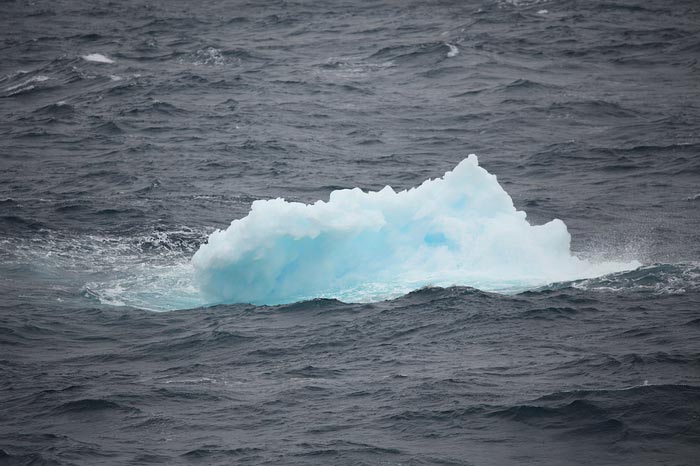Lesser known ozone layer’s outsized role in planet warming

Melting ice in the Southern Ocean.
Credit: Liam Quinn
Air pollution heating up the Southern Ocean.
New research has identified a lesser-known form of ozone playing a big role in heating the Southern Ocean — one of Earth’s main cooling systems.
Ozone is a gas composed of three oxygen atoms. Many studies have described ozone in the stratosphere, and its role in shielding people from the sun’s harmful ultraviolet radiation. Closer to ground level, in the troposphere, ozone is harmful to humans.
New research led by UC Riverside scientists reveals this lower level ozone is adding a great deal of heat to the Southern Ocean — more than scientists previously understood.
This finding has now been published in the journal Nature Climate Change.
“People haven’t paid much attention in the past to tropospheric ozone in terms of ocean heat uptake. Based on our models, they should be,” said Wei Liu, UCR climate scientist and lead author of the new study.
Oceans remove a majority of the carbon and heat that enter the atmosphere when humans burn fossil fuels. The Southern Ocean, also called the Antarctic Ocean, collects a third of all excess carbon in the world’s atmosphere, and an estimated 75% of the excess heat collected by the world’s oceans.
It is important to understand this heating so it can be controlled. Increased ocean warming is contributing to well-documented issues of sea levels rising.
To further this understanding, Liu and an international team of scientists explored climate model simulations with changes in ozone levels between 1955 and 2000. These model simulations isolated both stratospheric and tropospheric ozone from other influences on Southern Ocean temperatures, allowing them to see how each factor contributes.
While both stratospheric and tropospheric ozone contribute to the Southern Ocean warming, the team found that the latter contributes more.
“Historically, about a third of the ocean’s warming is attributable to ozone. For this third, about 40% is from the stratosphere, and the rest is troposphere,” Liu said.
In the 1980s, growing concern about a pollution-generated hole in the protective upper ozone layer led to the Montreal Protocol. A landmark environmental agreement, it codified the resolve of all 198 members of the United Nations to regulate chemicals generating that hole.
Though satellite images still show low levels of stratospheric ozone over the Antarctic, there have been improvements.
“Since the protocol was ratified, ozone depletion has recovered somewhat in the stratosphere, and climate models project it will continue to gradually recover,” Liu said.
Liu believes the results of this study are useful for showing where people can make further changes that will improve the environment.
Volatile organic compounds, or VOCs, from products like pesticides, tobacco smoke and automobiles are gases that form the building blocks of tropospheric ozone. The same is true for nitrogen oxides produced by combustion, or carbon monoxide from furnaces, gas stoves, and automobile exhaust. Many of these products can be modified to produce fewer VOCs.
“Tropospheric ozone is an air pollutant,” Liu said. “If we reduce our production of this, we get the dual benefits of less air pollution and most likely, less Southern Ocean warming as well.”
Journal: Nature Climate Change
DOI: 10.1038/s41558-022-01320-w
Article Title: Stratospheric ozone depletion and tropospheric ozone increases drive Southern Ocean interior warming.
Article Publication Date: 31-Mar-2022
Media Contact
Jules Bernstein
University of California – Riverside
Jules.Bernstein@ucr.edu
Office: United States
All latest news from the category: Ecology, The Environment and Conservation
This complex theme deals primarily with interactions between organisms and the environmental factors that impact them, but to a greater extent between individual inanimate environmental factors.
innovations-report offers informative reports and articles on topics such as climate protection, landscape conservation, ecological systems, wildlife and nature parks and ecosystem efficiency and balance.
Newest articles

Innovative 3D printed scaffolds offer new hope for bone healing
Researchers at the Institute for Bioengineering of Catalonia have developed novel 3D printed PLA-CaP scaffolds that promote blood vessel formation, ensuring better healing and regeneration of bone tissue. Bone is…

The surprising role of gut infection in Alzheimer’s disease
ASU- and Banner Alzheimer’s Institute-led study implicates link between a common virus and the disease, which travels from the gut to the brain and may be a target for antiviral…

Molecular gardening: New enzymes discovered for protein modification pruning
How deubiquitinases USP53 and USP54 cleave long polyubiquitin chains and how the former is linked to liver disease in children. Deubiquitinases (DUBs) are enzymes used by cells to trim protein…



